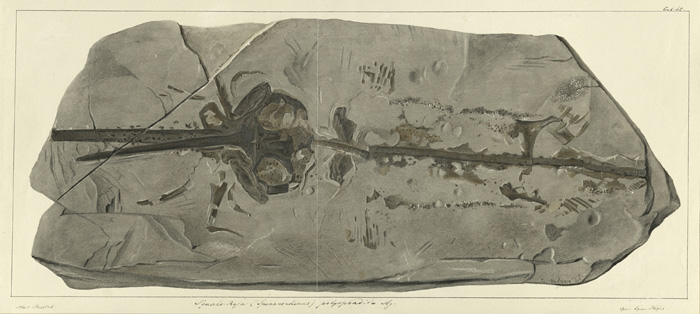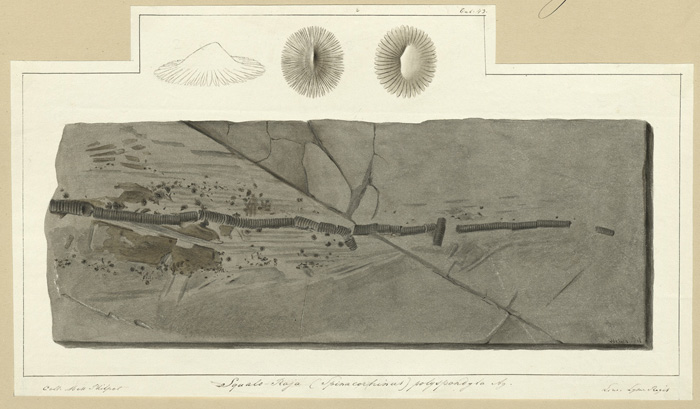
|
Watercolour of the front part of the fossil fish Squalo-raja (Spinacorhinus) polyspondila Agassiz, by Charles Weber, [1835]. Found in the Lias, Lyme Regis, from Bristol Museum. Archive ref: LDGSL/613/4/99/1
|
This rather strange specimen which she herself described as a ‘non-discript creature’ was found in two parts by Anning. The front part, comprising the head and vertebrae, measured around 17 inches (45cm), was discovered first probably in December 1829. Soon after Anning had written to her friend Charlotte Murchison and communicated with the geologist Charles Lyell (1797-1875, GSL membership no.498) about the fossil.
Word got round, and the find caused great excitement amongst the Fellowship of the Geological Society. Gideon Mantell (1790-1852, GSL membership no.463), in a letter Roderick Murchison in which he expressed his thanks to Charlotte Murchison for acting as an intermediary in acquiring fossils from Mary Anning for him, enquired if he’d heard any more about the new discovery.
"Are you aware of the destiny of the new fish with curling-iron eyes? Has Dr Buckland seen it, and is it, or is not a fish?" Extract from a letter from Gideon Mantell to Roderick Murchison, 21 January 1830. Archive ref: LDGSL/838/M/8/8.
Anning recognised that it was probably a new species of fish, and after advice, practiced comparative anatomy by dissecting a ray in order to see if there were any similarities, but decided that the anatomical differences in the vertebrae alone indicated that it was a different genus.
Despite its novelty factor, the specimen did not sell immediately. The Reverend David Williams (1792-1850, GSL membership no.746), pronounced that it was a type of saurian and offered £35 for it, which was rejected. Anning marketed it for sale to a number of other interested parties. Eventually John Naish Sanders (c. 1777-1870, GSL membership no.1173) purchased and donated it to the Bristol Institution. Apparently Sanders was under the impression that if Anning came across the missing tail, it would belong to him too. The tail was found, but was acquired by Elizabeth Philpot. Sanders’ application to Philpot to hand it over fell on deaf ears, and the tail survives in the Philpot collection at the University of Oxford Museum of Natural History.

|
| Watercolour of the tail Squalo-raja polyspondila Agassiz, by Charles Weber, [1835]. Found in the Lias, Lyme Regis, from the collection of Miss Philpot. GSL Archive ref: LDGSL/613/4/100/1.
|
The first scientific description of the new creature was published by physician Dr Henry Riley (1797-1847), one of the founders of the Bristol Institution, in the Geological Society’s Proceedings in 1833. Like Anning, Riley closely compared the bones to those found in rays, but broadened these studies out to find similarities with sharks (squales). His chosen name, Squalo-raia dolichognathos, indicated the belief that it was an intermediary of the two on the Great Chain of Being, the species name reflecting its seemingly long jaws.
The specimen came to the attention of the naturalist Louis Agassiz (1807-1873, Foreign membership no.1316) during his visit to the Bristol Institution in October 1834. Agassiz was immersed in the research for his work ‘Recherches sur les Poissons Fossiles’ (1833-1843/1844) which was an attempt to catalogue and classify all the fossil fish forms in existence. After digging around the matrix in front of the eye sockets with his penknife, Agassiz revealed some minute teeth, the supposed long jaws merely being an extension of the skull. When Riley’s paper proper was published in the Geological Society’s Transactions in 1837, the species name of ‘dolicognathus’ had been withdrawn as being no longer applicable.
The Bristol Institution had been reluctant to lend the specimen to Agassiz in order to be copied by one of his artists, suggesting instead that he should use a drawing which had been prepared for Riley’s original 1833 paper. The watercolour attests to Agassiz getting his way in the end, but Riley complained that the thoracic and pelvic regions were damaged, presumably picked away by the penknife-wielding Agassiz.
Despite the damage inflicted on the specimen, the watercolour is an important record of the fossil’s appearance as the original was destroyed during a WW2 air raid in November 1940. The specimen is now recognised as a type of chimaera, a cartilaginous fish sometimes called a ghost shark.
<<Back to main page
Next: Lady like find>>